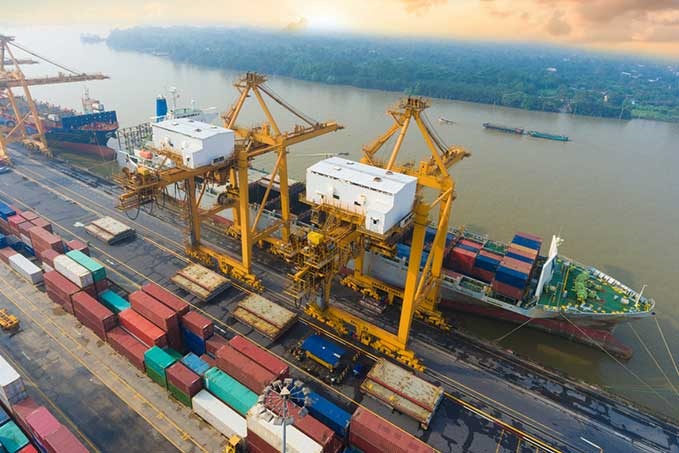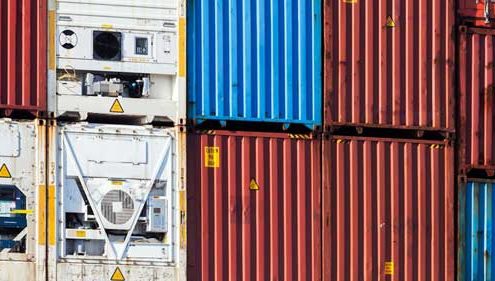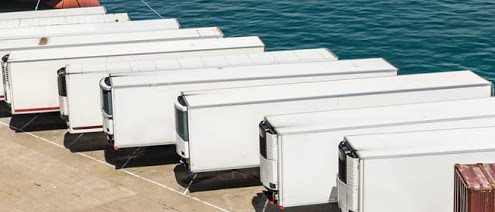
What is Drayage Service and How it Works for You
October 19, 2018What is drayage? Drayage is an essential logistics industry service and can play a role in the cold chain logistics industry. Learn about how drayage plays a role in the logistics process and this necessary step can work for you.
Understanding the drayage process and its origin can help you make the most of this logistics service. Drayage is a logistics term that involves shipping goods a short distance via ground freight. Drayage can help fill the gaps in intermodal shipping. The term drayage refers to a niche shipping service needed to move large containers for a truck, ship or rail. In shipping, drayage is a critical step in moving freight.
What is Drayage Service?
Simply put, the term drayage refers to a specialty logistics service that carries freight over a short distance. It is an essential part of intermodal shipping. Drayage is part of the container shipping industry. According to the Intermodal Association of North America (IANA), there are more than 60 million drayage movements each year in North America.
The term drayage also refers to a niche shipping service needed to move large containers for a truck, ship or rail. In shipping, drayage is a critical step in moving freight. How does freight get from a rail car to a ship? Additionally, how does a container get from rail to a truck? It all happens via drayage.
Drayage carriers must have necessary bonding and licensing. Drayage companies take containers in and out of warehouses, rail terminals, ocean ports and harbors. This often involves taking huge steel shipping containers off rail cars and ship decks and then loading them on to truck trailers. From there, the container is hailed to a warehouse or storage facility to get ready for the next step in the intermodal shipping process. Drayage is part of a longer logistics process.
In drayage services, the containers carried usually stay in the same metropolitan area or close region. This is different than broader regional or national shipping. Drayage transport can often be completed in one driver shift.
Before we get too far along, understand the term also has a number of additional meanings throughout the industry.
Drayage also means:
- Vehicle used to collect shipment at a boarder, ocean port or intermodal point
- Name of the fee charged for the services
Transporting Using Drayage
The distance and time-frame it takes a drayage service to move a container amounts to a very short period in the overall travel journey of the shipment. When a container ship arrives in port, a large contingency of drayage service drivers quickly move in place to transport assigned cargo.
Drayage also means transporting cargo to a warehouse, to another port or deliver to end destination within a specified radius. A number of companies are able to cover a diversity of services. However, others may select to develop a niche like only rail-to-rail drayage.
In shipping, drayage is a necessary step to keep everything moving smoothly toward delivery. However, as will other aspects of shipping, things occur that could cause drayage delays by a few hours or even days. Most services have the ability to shift resources to make up the time because of the short distances.
Drayage is an essential step in the supply chain. The only way your freight can make it from the port or intermodal terminal to the next mode of transport is via drayage.
What is Intermodal Shipping?
Intermodal shipping is a way of moving cargo or freight that involves multiple methods of shipping. Intermodal shipments might travels on a combination of truck, ship, rail or airplane. In most cases, intermodal shipments use special containers so that goods can be transferred between modes of transport without having to be unpacked.
According to the Intermodal Association of North America (IANA), up to 95 percent of all globally manufactured goods travel in a container at some point. This means intermodal shipping applies to many different kinds of cargo.
Drayage services connect these containers of freight from one intermodal point to another. For example, drayage service might include transporting a container from a receiving dock at an ocean port to a trucking terminal for transport to its final destination.
Drayage Classifications
Drayage service isn’t a one-size-fits-all method. You’ll find a number of classifications of drayage services. The following classifications come from the IANA:
- Expedited drayage: Freight containers are transported quickly. This best applies to time-sensitive shipments.
- Inter-carrier drayage: This is what comes to mind first when most people think of the word drayage. It involves the movement of goods between different carriers. As an example, inter-carrier drayage might involve transporting goods from a trucking terminal to a rail station.
- Intra-carrier drayage: Intra-carrier drayage involves taking freight to two different hubs owned by the same carrier. Cargo might be transported from an intermodal hub to a rail hub.
- Pier drayage: Do you need cargo to move from a rail terminal to an ocean shipping dock or pier? You might need pier drayage. This methods uses highways to get freight to the pier.
- Shuttle drayage: Shuttle drayage involves moving an intermodal unit to a temporary stopping point. This method is used when the hub of origin might be overcrowded.
- Door-to-door: Delivery by truck of container to retail customer
The classification of service you select depends on your shipping needs.
Shippers should determine which type of drayage service best serves the cargo for delivery to complete the next leg of the journey. Moreover, it may be necessary for a freight container to transfer via drayage service multiple times during shipment.
The freight, if moved by intermodal drayage, would involve more than one transportation type before reaching a final delivery point. Shipping using intermodal drayage makes up a lion’s share of the sector.
Each service category covers a variety of things for the shipment. The assigned driver may take the freight several hundred feet to a waiting truck or haul the cargo a few miles away to a warehouse near the port.
Whether the freight goes from truck to rail or ship to warehouse or any other combination, the link in overall supply chain is drayage service. Think of drayage as the short distance runner in the marathon of shipping.

Drayage Service and the Cold Chain
Refrigerated shipping containers can make drayage a part of the cold chain. These units, also known as reefer containers, are designed to maintain a low temperature for perishable goods during the shipping process. Reefer containers can be used to ship items that must maintain a constant temperature. Items like pharmaceuticals, produce, food, cut flowers and more are commonly shipped in refrigerated containers.
The cold chain must never be broken, especially for services like how to transport ice cream and shipping fresh produce. Cold chain logistics refers to the process of shipping, storing and distributing cold and frozen goods.
Refrigerated containers are designed to work independently. This means they’ll stay cold regardless of whether they are traveling by rail, on a truck or over the sea. Reefer containers are insulated by nearly 1,000 pounds of foam and feature their own cooling mechanisms. Reefer containers work like the refrigerator in your kitchen, but on a larger scale. Three main components make the reefer trailer work: the compressor, condenser and evaporator help the container stay cool.
Cold chain logistics relies on drayage service to get goods from one mode of shipping to the next.
The History of Drayage Service and the Cold Chain
Drayage isn’t a new concept. Current drayage methods use state-of-the-art trucks and modern containers. But did you know that drayage dates back to before the 18th century? Historians say that drayage predates the industrial era.
In fact, the term drayage comes from the word “dray.” A dray was a cart drawn by horses. Dray horses hauled very heavy loads of freight. Because the freight was so heavy, the horses could only travel short distances. The horses and carts worked near ocean ports, canal terminals and railroad terminals. Dray horses and carts worked until trucks took over in the 1910s.
The cold chain isn’t new either. The first cold shipments took place in the 1840s. Shippers waited until the weather was cold outside, and then shipped their perishable items on ice to maintain their cold temperature. Cold chain technology progressed in the 1910s, when cold items were then shipped on ice in trucks. The first version of today’s modern reefer trucks first hit the road in 1942, when the refrigerated truck was invented. Since then, reefer trucks and containers have made the cold chain possible.
Why Drayage Service is Needed
In addition to ports with intermodal containers, retail venues along with trade show sites also use drayage service. Similar to moving cargo at a port, a lot occurs behind the scenes at shopping malls and trade shows.
Take shopping malls for instance. Getting freight in and out of stores, especially those without external loading areas, takes coordinating with a drayage service to get a shipment from the delivery truck to the storefront. Typically, a common delivery hub is available at retail malls. However, this short distance is critical for the store to cover on a regular basis.
The busy world of trade shows also depends on drayage service to move exhibitors in and out of the site in an efficient manner. Once materials for each exhibitor arrives at the location, it is a frenzy of activity to get everything ready. Exhibitors may send a team to construct displays a few days in advance.
Carriers contracted by the exhibitor delivers the shipment to the convention center, or venue for the trade show. Next, the drayage service takes over to move the freight the short distance from the loading dock to the exhibitor’s space on the tradeshow floor. While drayage covers a relative short distance, everything is typically is happening at a steady pace. Crews are on hand to get seasonal merchandise stores or transfer exhibit booths and equipment to the right spot.
Drayage services are the unsung heroes in the background, making sure to finish the job so others look good. When the show wraps up, the service returns to move everything back out to the dock area, ready for carrier pickup.
On occasion, the question may arise if drayage service is required. The answer is likely yes because of what it takes to move freight from the dock to the intended space.
How to Contract Drayage Service
When the need arises to contract drayage service, a few things may be helpful to inquire about when obtaining quotes.
- How does the company calculate rates?
- Is tracking available for shipments?
- Will storing empty crates or cartons be an extra fee?
- When is delivery to space scheduled?
- What is the timeline of delivery start/finish?
Knowing in advance the service level or if other fees will be charged can help in budgeting for the service ahead of time. In some cases, the drayage service offers an inclusive package covering multiple aspects for one price.
In a retail or trade show setting, the driver from the dray service may have more flexibility in their schedule versus the driver working an ocean or rail transfer.
Types of Drayage Containers
The containers used for shipping freight come in several size specifications and with different functions. A standard size container is either 20-feet, 40-feet, or 45-feet in length. Most containers are between 6-feet to 8-feet in height.
Each container, made of either steel or aluminum, have maximum weight restrictions on contents loaded for shipment. A refrigerated container is also available to transport freight that must maintain a specific temperature.
Container types include:
- Dry or standard
- Open top
- Flat Rack
- High Cube
- Refrigerated
The standard size and functionality of the containers make them easy to load or unload for a variety of transport modes. Yes, these containers are some of the same ones you often see while waiting for a long line of train cars to whiz by.
A contracted drayage service should be well equipped to handle any of the standard shipping containers.
ABCO Transportation and Drayage
What is drayage? Now you can answer this question confidently. ABCO Transportation can be your partner in cold chain logistics and drayage. Our experienced and professional team has the skills and knowledge needed to get your perishable items from here to there. Take advantage of our cold chain experience and let us work for you.

